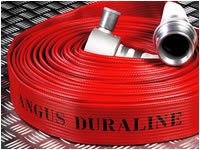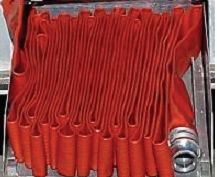 |
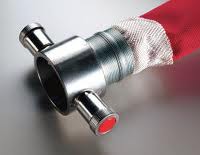 |
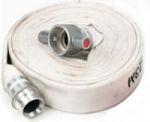 |
Fire hose (as we now understand it) , can trace its ancestry back over 250 years. Starting life as long strips of leather sown or riveted together, it has evolved into the efficient and effective high-tech hose now used by modern Fire service's In common use in the UK is 45mm (1 3/4 inch) and (notionally) 70mm (actually 64mm 2 1/2 inch). The Hose design is governed by a British Standard, BS 6391:2009. The "instantaneous" couplings on each end (one male, one female) are also to a British Standard, BS336. The British standard details 3 Types (categories) of fire hose: Type 1 and Type 2 hoses comprise a circular woven jacket or reinforcement of a synthetic fibre with an impermeable internal lining.
Type 1 hoses have no external treatments applied.
Type 2 hoses have external coating has been applied to the reinforcement to give some protection against the absorption of liquids and to improve resistance to abrasion.
Type 3 hoses have an external elastomeric coating or has a covering applied to, or been incorporated in, the reinforcement to give the hoses very low absorption of liquids and high resistance to abrasion and heat.
Type 3 Hose is in commonest use in UK FRS's. Although it it has proven rugged and durable it is (by its very nature) heavier than type 1 or 2. This is a consideration for High rise fire fighting, where equipment may be have to be carried up many flights of stairs.
Recent trials of some lightweight type 2 hose (HFRS / GMFRS 2010) have proven that the specific hose used was not durable enough for the expected internal fire environment (suffering significant wear and tear).
Internationally there are many Hose manufactures that are making lightweight and ultra durable hose, ideal for High rise fire fighting. Unfortunately most have not been assessed to BS 6391

Photo: Niedner. RXL-800 Lightweight hose
Hose Selection
Repeated tests and trials in the high-rise environment have directed UK-FRS to 51/52mm hose.
This hose offers the optimum performance given the restricted environment it needs to work in. The primary restriction is the water supply. 51mm hose offers a good balance of hydraulic performance (frictional loss). Together with usability and flexibility within manual handling (crews need to be able to safely advance and retreat.
Hose weight is an issue that should be addressed and this needs to be balanced with the ability of the hose to withstand the hard environment of a High-rise fire. Although using lightweight hoses is very beneficial, the hose does need to be able to perform its primary function and withstand the riggers of the high rise fire enviroment.
38mm Hose: Is a narrow bore hose that is light and very maneuverable. It is frequently used at Forestry, Marine and Ship fires. It also exhibits very high frictional loss and should NOT be considered for incidents at high rise incidents as it will not normally be able to provide suitable flow rates given the issues of limited supply from riser systems.
45mm Hose: Is the normal hose taken inside a building. In most circumstances it exhibits a good balance between its flow characteristics, its charged weight and manoeuvrability. It is important to note that when there is any restriction placed on the supply to any 45mm hose (which is to be expected at High rise incidents) its flow characteristics, especially its high levels of frictional loss, will count against it. In some circumstances hose lines may need to deployed in high rise buildings that are over 2 lengths long (50m plus). A single 25m length of 45mm hose, at a tactical flow rate of 500l/m can experience a frictional loss of 1.5 Bar. Longer hose lines consisting of purely 45mm hose will lead to very significant restrictions in flow rates.
51mm / 52mm Hose: This hose has been identified as providing the best balance of flow characteristics, charged weight and manoeuvrability in the high rise environment.
70mm (64mm) Hose: Commonly revered to as 70mm hose (although only 64mm in diameter) this is the mainstay hose for most UK FRS. It offers superb flow characteristics but is heavy when fully charged and extremely difficult to manoeuver. Test in the high rise environment have proven that deploying lines of 70mm into compartments was extremely arduous, even for 3 person crews.
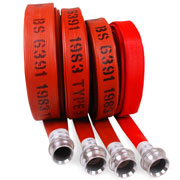 |
 |
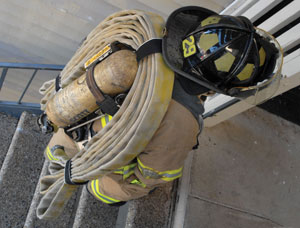 |
||
| Photo : HoseEco UK Ltd. | Pic:Fire-end.com | Photo :Glen Ellman |
Hose management
Stowage and Deployment.
Hose make-up (how its laid ) prior to deployment is an import consideration. Four common methods are :
Photo: Angus Kidd |
Rolled make-up systems have a proven record, but its short-coming is that it has to be deployed (Hand rolled). This requires space, which can be a serious restriction in high rise corridors and lobbies. |
Dutch rolled (or 'Hose on the Bight')
Photo: Greg Stone |
Dutch rolled, where the hose is double back on itself and then rolled towards the two couplings is a quick and convenient hose make up & deployment but it requires conciderable space to deploy (it is thrown) making it less than ideal foir high rise corridors and lobbies. |
: Flaked (zig-zaged)
Photo: NZFS training Program |
Flaked hose is used extensively in the USA and historically, the UK FRS had 'quick deployment lines' pre-made up, in the pump locker. This usually consisted of 2 lengths of 45mm hose, flaked in a tray in the pump (rear) locker, and a pre-connected branch. |
Carmel / Cleveland lay (Often called Roundabout hose load or Carmel lay or a part of a Cleveland load, which includes a branch)
Photo : Highrisefirefighting.co.uk |
|
| Carmel (or Cleveland pack) is an evolution of an American 'wildfire' hose deployment technique. In tests and trials it has proven extremely beneficial both on terms of hose management and deployment speed. Restricted space tests have been carried out and this method seems to provide the simplest and quickest deployment in areas such as corridors, stairwells and lobbies. The Cleveland/Carmel make-up is by far the best for high rise, limited space, deployment. |
These make-ups are normally appliance stored in a tray or racking. Pre-loaded High Rise load bags may also contain lengths of hose. Recent innovation has lead to the creation of hose pack holders to assist with quick and effective deployment.
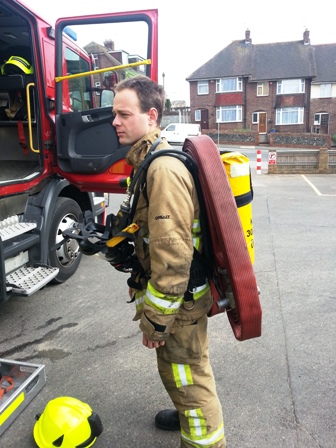 |
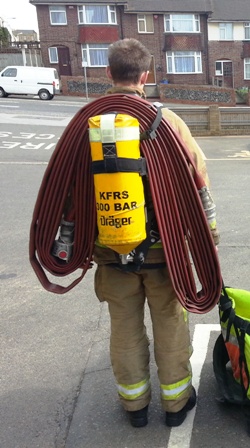 |
Pic:Highrisefirefighting.co.uk
Recent research in the UK has identified that the prefered deployment for hose is Cleveland/Carmel carried over the shoulder (in the American style)
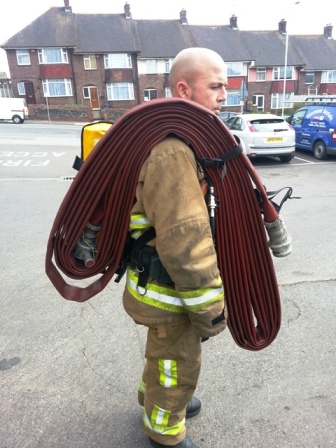 |
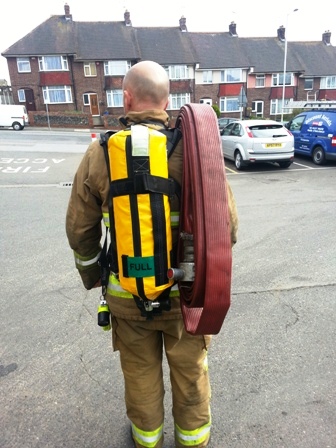 |
Pic:Highrisefirefighting.co.uk
Ensure that the selected method of make-up is approved by the hose manufacturer and that it places no undue loads or stresses on it .
The stowage system and make-up can have a bearing on the speed of deployment. On arrival it must be easy for crews to select, remove and deploy hose to the appropriate incident areas.
The commonest make-up methods on UK appliances is one of the rolled methods; either conventionally rolled (over the female coupling) or dutch rolled (where the hose is double back on itself and then rolled towards the two couplings). These are not best suited to high rise deployment.
 This link will take you away from www.highrisefire.co.uk Please be aware that we do not necessarily endorse or support the views, opinions and expressions of this site !
This link will take you away from www.highrisefire.co.uk Please be aware that we do not necessarily endorse or support the views, opinions and expressions of this site !
